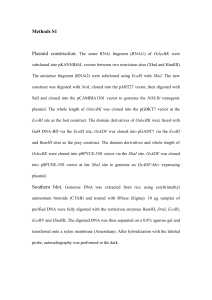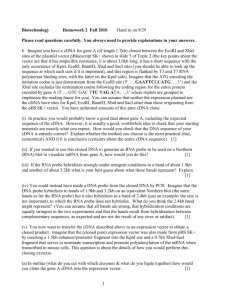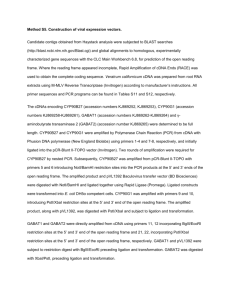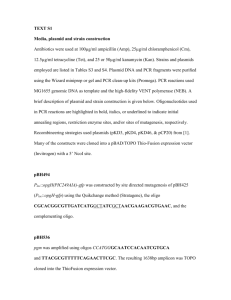nph12418-sup-0002-MethodsS1
advertisement
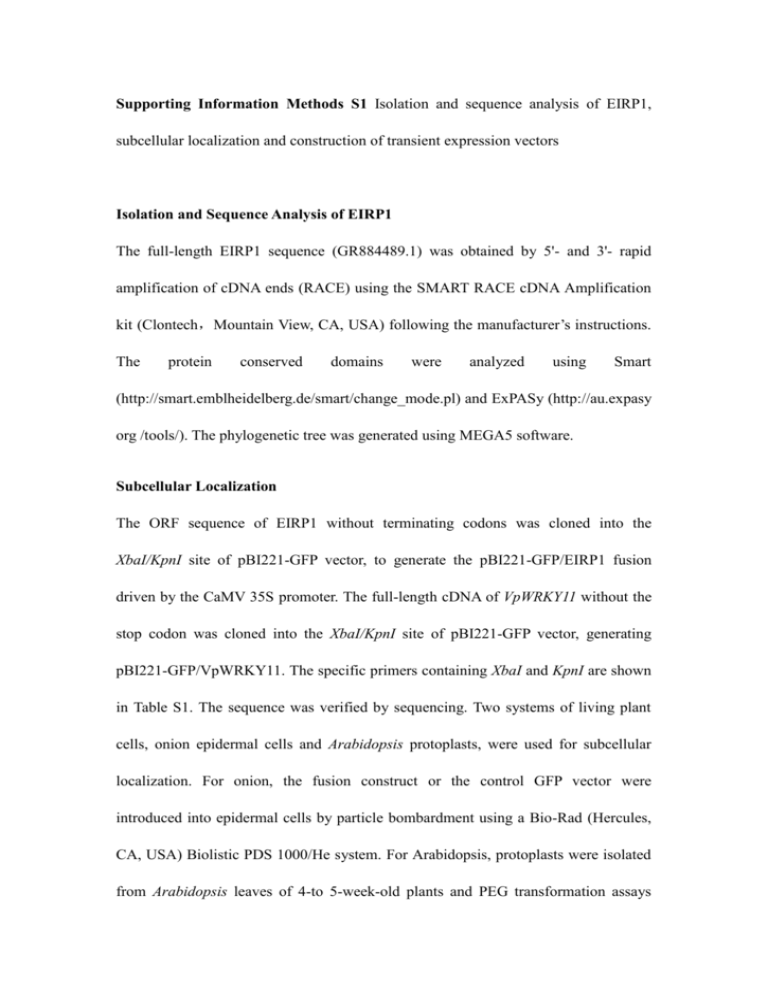
Supporting Information Methods S1 Isolation and sequence analysis of EIRP1, subcellular localization and construction of transient expression vectors Isolation and Sequence Analysis of EIRP1 The full-length EIRP1 sequence (GR884489.1) was obtained by 5'- and 3'- rapid amplification of cDNA ends (RACE) using the SMART RACE cDNA Amplification kit (Clontech,Mountain View, CA, USA) following the manufacturer’s instructions. The protein conserved domains were analyzed using Smart (http://smart.emblheidelberg.de/smart/change_mode.pl) and ExPASy (http://au.expasy org /tools/). The phylogenetic tree was generated using MEGA5 software. Subcellular Localization The ORF sequence of EIRP1 without terminating codons was cloned into the XbaI/KpnI site of pBI221-GFP vector, to generate the pBI221-GFP/EIRP1 fusion driven by the CaMV 35S promoter. The full-length cDNA of VpWRKY11 without the stop codon was cloned into the XbaI/KpnI site of pBI221-GFP vector, generating pBI221-GFP/VpWRKY11. The specific primers containing XbaI and KpnI are shown in Table S1. The sequence was verified by sequencing. Two systems of living plant cells, onion epidermal cells and Arabidopsis protoplasts, were used for subcellular localization. For onion, the fusion construct or the control GFP vector were introduced into epidermal cells by particle bombardment using a Bio-Rad (Hercules, CA, USA) Biolistic PDS 1000/He system. For Arabidopsis, protoplasts were isolated from Arabidopsis leaves of 4-to 5-week-old plants and PEG transformation assays were conducted according to the method as described previously (Yoo et al., 2007). Transformed materials were incubated in darkness at 24°C for 16-18h in a growth chamber. Nuclear DNA staining with DAPI. GFP signals were detected with a Zeiss LSM 510 confocal laser microscope using a 488 nm filter (Zeiss, Oberkochen, Germany). All transient expression assays were repeated at least three times. Construction of transient expression vectors For generation of the RNAi-EIRP1 construct, a 723 bp fragment of EIRP1 coding sequence was amplified using primers dsEIRP1-F1 and dsEIRP1-R1, dsEIRP1-F2 and dsEIRP1-R2, and cloned into vector pKANNIBAL in the sense direction at BamHI and ClaI, and in the antisense direction at XhoI and KpnI, respectively. For preparation of the RNAi-VpWRKY11 construct, a 1083 bp fragment of VpWRKY11 coding sequence was amplified by using primers dsVpWRKY11-F1 and dsVpWRKY11-R1, dsVpWRKY11-F2 and dsVpWRKY11-R2, were inserted to pKANNIBAL in the sense direction at XbaI and HindIII, and in the antisense direction at XhoI and KpnI, respectively. The expression cassettes constructed in pKANNIBAL, which include the dsRNA constructs for EIRP1 or VpWRKY11 and the spanning CaMV 35S promoter and OCS terminator sequences, were released by NotI and cloned into the NotI site of binary vector pART27, respectively. For constructing pC139135S-GUS, a CaMV35S promoter fragment was added to the multiple cloning sites from pCAMBIA1302. The full-length cDNA of VpWRKY11 was PCR amplified and cloned into the PstI/BamHI site of the pC139135S-GUS vector, generating pC139135S-GUS-VpWRKY11. The full-length cDNA of EIRP1 was PCR amplified and cloned into the XhoI/BspT1041 site of the pER8-3×FLAG vector, generating pER8-3×FLAG-EIRP1. For analysis of the promoter activity of EIRP1, the promoter sequence was cloned into the PstI/BamHI site of the pC0390GUS vector. The full-length cDNA of VpWRKY11 was PCR amplified and cloned into the BglII/BstEII site of pCAMBIA3301 vector, generating OE-VpWRKY11. The specific primers are shown in Table S1. The sequence was verified by sequencing. The resulting plasmids were introduced into Agrobacterium tumefaciens GV3101 by electroporation for plant transformation. Yoo SD, Cho YH, Sheen J. 2007. Arabidopsis mesophyll protoplasts: a versatile cell system for transient gene expression analysis. Nat. Protoc. 2: 1565–1572.
